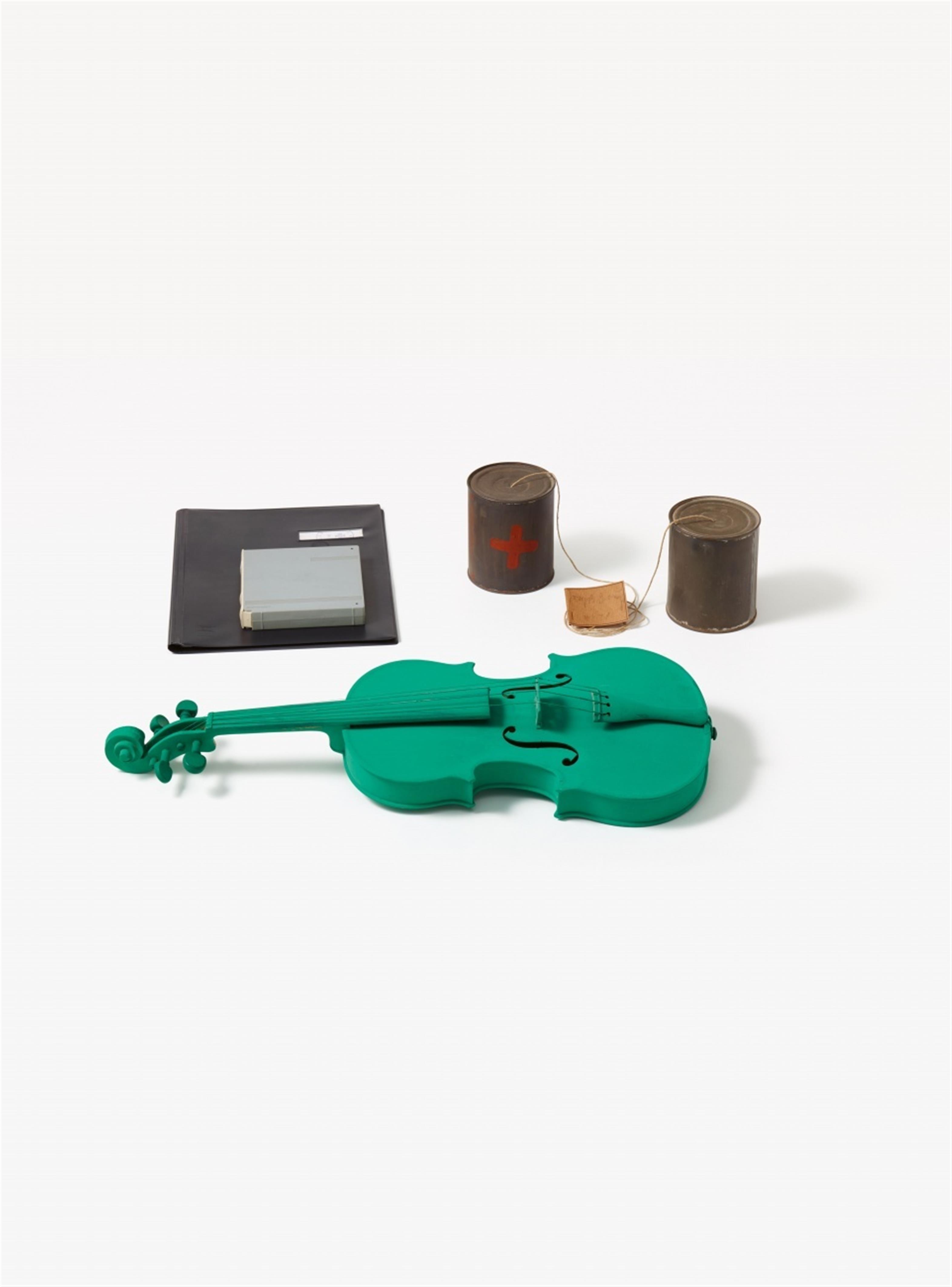Joseph Beuys
Henning Christiansen
Joseph Beuys und Henning Christiansen
2 Fluxus-Objekte (Musik als grün. Telephon S)
1974
Zwei Objekte, Tonband und Text mit Abbildungen.
Musik als Grün: Grün gefasste Geige, gestempelt "FLUXUS ZONE WEST" (stark verblaßt).
Telephon S: Zwei Blechdosen, eine mit brauner Farbe (Braunkreuz), mit Faden miteinander verbunden Two objects, tape and text with illustrations. Musik als Grün: violin painted green, stamped "FLUXUS ZONE WEST" (faded). Telephon S: two tin cans, one with brown colour (Braunkreuz), interconnected by a thread. Violin: approx. 21 x 60 x 9 cm; tin cans: each 11.8 x 10 cm. Signed and numbered on label. Numbered 17/24. Text as photocopy facsimile in 6 sheet protectors in plastic folder 32 x 25.5 x 1 cm. BASF tape 14.5 x 14 x 2 cm. Edition Schellmann, Munich. - Minor traces of age.
Only about 12 copies of the edition with tape and text were realised.
Since the 1950s, Joseph Beuys had not only occupied himself with drawing and traditional sculpting <https://de.wikipedia.org/wiki/Bildhauerei>, but also with ritual actions in the context of the Fluxus movement that had been developing since the early 1960s and had been founded by the American Georg Maciunas. In the beginning, it was regarded as a secret “art spectacle”, but became increasingly popular with the participants in seemly evening dress. For Beuys, this was also an opportunity to give creative expression to his sensitive urge to send messages. “My Fluxus activity began in 1962 when I spoke to Nam June Paik about all kinds of activities that could and perhaps even should be carried out. At some point we met with Maciunas, who was in Wiesbaden with the American Army, to discuss organisational questions, programme arrangements and the possibility of tours.” (Quote from Joseph Beuys. Skulpturen und Objekte, Heiner Bastian (ed.), Berlin 1988, p.93). This marks the beginning of a series of more than 40 concerts and individual spiritual actions that Beuys carried out alone or with various artists until 1985.
The first collaboration between Beuys and the Danish composer and musician Henning Christiansen took place in December 1966 at the Schmela Gallery in Dusseldorf with the action 'Manresa' ('Hommage à Schmela'). The title 'Manresa' refers to the town of the same name in Catalonia, where Ignatius of Loyola, co-founder and designer of the Society of Jesus, lived for a long time in strict penance.
Another performance by Beuys with Christiansen, who played the green violin, took place on the occasion of the concert 'Hauptstrom FLUXUS' in the Galerie Franz Dahlem in Darmstadt as part of the exhibition 'Fettraum' on 20th March 1967. The two Fluxus objects, 'Telephone S ---- E' and 'Violin', are relics of the joint performance, which lasted from 1 pm to 11 pm.
“It isn't the cans alone that accomplish this, basically, they only imply a very simple elementary process, the concept of transmitter and receiver, i.e. of two stations, whether these are individual people or groups that are connected to each other. A connecting cord and a positive and a negative pole, and the two now converse with each other. Thus no statement has yet been made as to what a contemporary information theory would be. The can cannot accomplish that, but the cans can stimulate it, give an impulse when an intuitive person comes across these things. But it is not necessarily so, someone else can come by, he just sees two cans, after all they are no worse than a sculpture by Brancusi ....", Beuys said in a conversation with Jörg Schellmann. (Joseph Beuys in conversation with Jörg Schellmann and Bernd Klüser, June 1977, in: Schellmann, 1992, pp.20, 24).
Joseph Beuys did not say a word about the violin itself. It is a “normal” instrument with the peculiarity of being painted green. “My own instruments are all painted green, 'Musik als Grün' (music as green), I have to do something in order to observe the matter with new eyes,” Christiansen said in his contribution “Produktionseskalation und Selbstkontrolle” (production escalation and self-control) (in: Begleitheft zu den Relikten des Instrumentalkonzerts (in: accompanying booklet on the relics of the instrumental concert)). And it bears the stamp “Fluxuszone West” with which Beuys assigns the green violin to his work. Certainly the can and the violin have something in common: their two cavities serve as soundboards for tones.
Catalogue Raisonné
Schellmann 135 and 136

